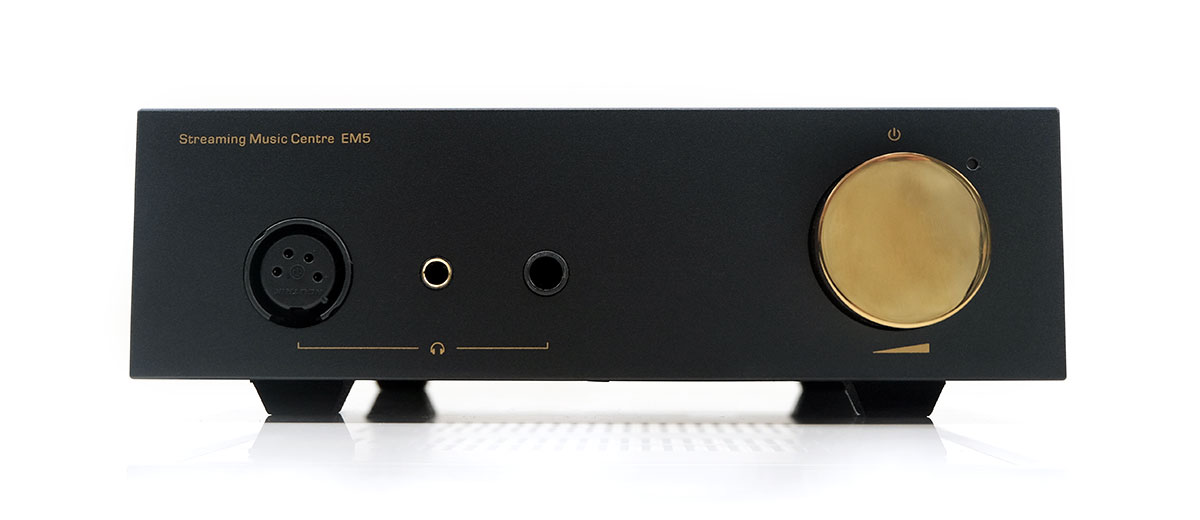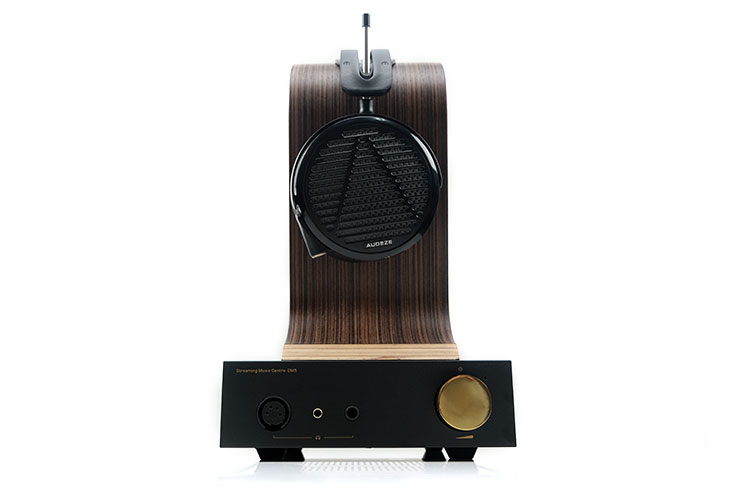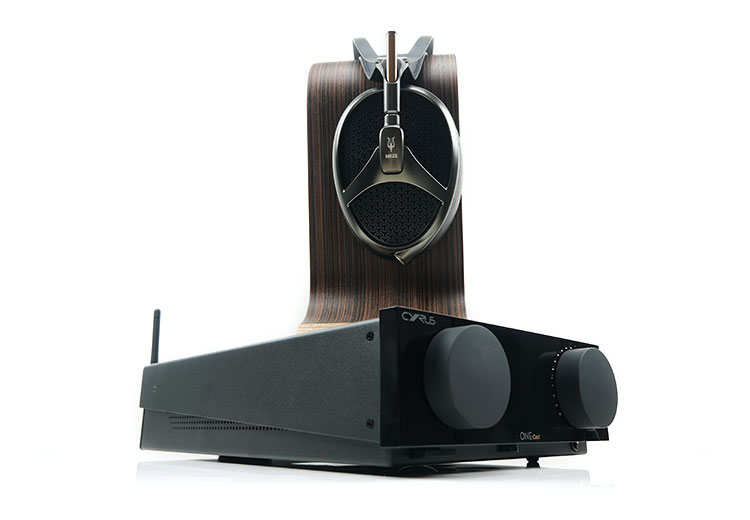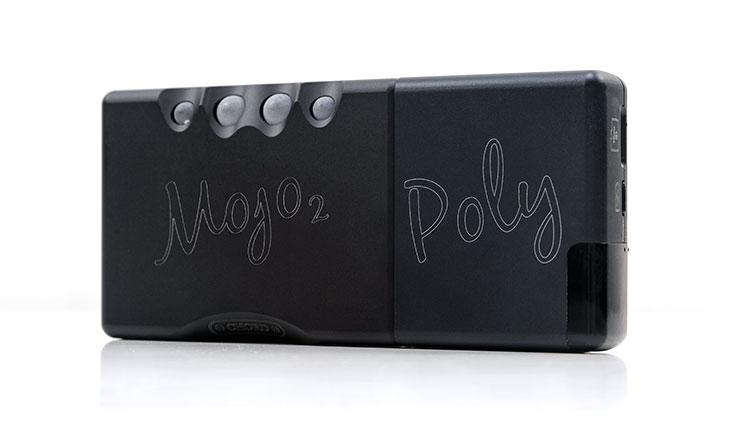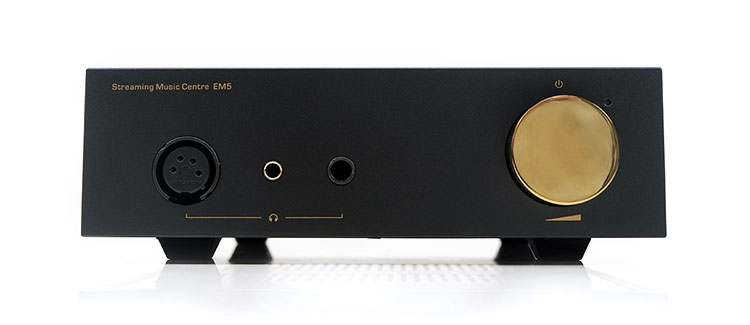Synergy
Efficiency
The EM5 is an IEM friendly desktop amplifier with a 0.6Ω rating on the SE output though at 1.6Ω on the balanced is higher than I would have preferred. Having said that, the likes of the Andromeda 2020 did not suffer from any sort of skew quite like the Cyrus Audio’s One Cast which is a competing all-in-one DAC/amp.
Here the Andromeda 2020 in SE sounded more accurate and balanced, and true to the expected impedance curve whereas with the One Cast it sounded thin and lacking in bass. You can read in more detail how that went with the comparison further down this page.
The EM5 volume control is also in the digital domain so whilst not quite the same micro-adjustment level as the portable Mojo 2, it does have excellent channel balance at very low volumes and good control on the low-gain settings. You can still use sensitive IEMs even on the turbo gain setting but the noise floor is not as low with an audible signal even on zero.
For headphones, the EM5 can scale quite well with its balanced output. Tested where the RAD-0, Liric, and the LCD-5 and all 3 are reasonably moderate in their load and current demands but still shine better with more on tap.
None of them sounded short-changed in terms of dynamic range and showed improvements in terms of resolution and channel separation over the likes of the SE One Cast. However, I do have preferences and you can read more about that in the pairing selection below.
Headphone Pairings
The EM5’s classic AKM tuning lends itself well to high-impact headphones and IEMs with a solid low-end response as well as controlled mids and highs.
I say controlled because I found myself shying away with the likes of the Liric as a good pairing and it does tend to sound hotter when its upper mids and treble are pushed hard. The EM5 does emphasize that particular frequency range alongside the more aggressive bass imaging.
Combined with the EM5’s relatively clean overtones the Liric can sound a bit peaky with high energy synthy music or aggressive percussions passages. The clarity is excellent and there are zero issues with its dynamic range and bass impact. Rather it’s the harmonic dissonance on the highs which can be too distracting for me personally.
You would have expected the upper-mids aggressive LCD-5 to sound the same? Well, surprisingly no, it did not actually. It was certainly forward but somehow the treble stayed relatively neutral with a better balance compared to the Liric.
This is a lively pairing with vocals to the fore and a punchy low-end. You can soften the harmonic balance a little by going single-ended but I prefer the better control and wider staging quality going balanced.
The Rad-0 was an excellent pairing, probably my favorite of the three. It has that old-school Audeze sound with a solid instrumental fundamental that gels really well with the EM5’s punchy sound signature.
Mids and treble are natural-sounding to slightly sweet without a hint of treble sharpness that I had with the Liric. They might sound a little leaner than our compared amps, the Mojo 2 and the One Cast, but using the balanced output, they have more headroom with wider stereo imaging.
Select Comparisons
Cyrus Audio One Cast
$1999
Reviewed by us in the 3rd quarter of 2021 the One Cast is a little bit more expensive than the EM5 but pitched in almost the same all-in-one category as the cheaper Shanling alternative.
Technical
Both of these desktop devices serve as a DAC, headphone amplifier, and pre-amp. However, the One Cast goes further and inserts another Class D speaker amp on top of its Class AB headphone amp that can directly drive passive speakers.
To get that kind of setup you have to switch to the EA5 from Shanling which might also be closer to the One Cast target audience compared to the EM5. I say closer because aside from the similar direct-to-speaker implication, the EA5 also only offers a SE topology for headphone PO.
The EM5 is a balanced circuit from back to front with more output power at 1.6W into 32Ω at its highest gain setting compared to just 1W into 32Ω from the One Casts’ 6.35mm SE output. It can also pre-amp or line-out balanced with a higher 5.5V setting, (balanced), compared to the One Cast 2V SE analog pre-outs.
Neither has what I would call top-of-the-line DACs with single-channel implementations also. However, I do rate the EM5’s AK4493EQ as a little more suited to desktop setups compared to the One Cast’s ESS ES9018K2M which is a 2-channel mobile solution.
You can see that advantage in the decoding numbers with the EM5 able to handle up to DSD256 and PCM 32BIT/384kHz as well as MQA 8X whereas the One Cast stops at PCM 32BIT/192khz and DSD128. It has no MQA unfolding capability either so it is going to be more attractive to Qobuz users rather than TIDAL fans.
Feature Set
The feature sets are always where an all-in-one appeals the most. If it is just a pure numbers game, the One Cast has a lot more in terms of features. Not only is it a headphone amp, pre-amp, and speaker amp but it also offers a phono stage and ARC HDMI connectivity. In reality, it is most at home in a home entertainment system with headphone options.
The EM5 is more of a headphone amp and DAC with streaming and digital input capability with its additional ethernet RJ45, multiple optical and coaxial I/O as well USB-B and USB-A for OTG. The EM5 is still a home bird but more of a soloist for the streaming enthusiast.
Software
Software plays a huge role with these two units and here I think Cyrus Audio got it just right with its Chromecast integration using Google Home rather than a dedicated internal app built on Android.
Granted, the vast majority will use Google Home as a remote on an Android phone but with so many apps using Chromecast built-in, it’s more of a simple protocol handshake via WiFi to get started. Apps like Spotify, TIDAL, Qobuz, and Roon all have built-in Chromecast capability and can see the One Cast right away.
The EM5 has more of a DAP-like logic to its connectivity with the use of Android and some NAS features including its Eddict Player app for remote controls.
It works very much as you would expect if you are using a DAP except for me, the software is a bit dated and not as intuitive as Chromecast. Some users though will prefer that native IPS panel for specific controls combined with the onboard storage for local playback which the One Cast does not offer.
Both have similar performance for WiFi but as dated as the EM5 is for Bluetooth it still offers a better codec suite including up to LDAC compared to the SBC-only performance of the One Cast.
Performance
Impedance
The biggest problem with the One Cast performance is the output impedance of its headphone PO in SE which I am almost 100% sure is well over 1Ω, possibly higher than 2Ω. In the original review last year, I mentioned this would skew the impedance curve of most sensitive IEMs and something which the EM5 successfully avoids.
For example, the Andromeda 2020 sounds balanced, clear, and resolving with the EM5 with a very quiet background. With the One Cast, it is bright, lean, and shallow sounding which is a very inaccurate representation of the core One Cast output sound and the Andromeda 2020 itself.
Another example is the VE EXT which sounds like its electrostatic drivers have been switched off on the One Cast. You get a very muffled and veiled performance with almost no high-end whereas, with the EM5, the EXT sounds much more spacious and balanced tonally with a proper treble performance.
Not every IEM will skew such as the Empire Ears Legend EVO which sounded spot on with both amps. Here you can hear the difference between these two amps properly with the One Cast offering a slightly warmer denser sound but imaging a bit more on the neutral side so it sounds comparatively relaxed.
The EM5 has that classic excitable and more rambunctious AKM sound from a few years back with a slightly cooler timbre but more impactful sounding on the low-end and vivid vocals to mid-highs pushed more to the fore. That means percussion and vocals stand out on the EM5 with some cleaner overtones whereas lower-mids to mids have more girth and body on the One Cast.
Balanced Difference
You get the same tonal balance moving up to headphones such as the Rosson Audio Design RAD-0 and the HE6SE. However, the dynamic range and channel separation become more of a factor here with the EM5’s stronger 1.6W balanced output delivering more of both compared to the One Cast’s 1W SE output.
Aside from a minor peak around the upper mids on the EM5 with edgier headphones such as the HE6SE, the EM5 sounds the more accurate of the two for instrumental and vocal timbre. It also has a clearer and more spacious staging presence The One Cast’s instrumental separation and imaging placement are quite centered and comparatively compressed sounding.
Chord Electronics Mojo 2/Poly Combo
£449 & £449
The second comparison is a bundle consisting of the recently released Chord Electronics Mojo 2 and its wireless partner, the Poly. Quite a contrast in use application but with a price point and set of similar wireless features it might be an alternative option, especially for easy-to-drive headphones and IEMs.
Technical
The Mojo 2 is primarily a battery-powered portable device and does not offer any pre-amp or dedicated line-outs for power amps or speaker integration. Neither is it a balanced circuit, offering dual SE 3.5mm TRS outputs only compared to the EM5’s XLR and 4.4mm balanced and 6.35mm SE outputs.
Power for SE is actually better from the Mojo 2 at 600mW into 32Ω compared to 540mW from the same load on the EM5. However, the balanced factor is an advantage with the EM5 much more powerful at 1.6W into 32Ω. I would take the Mojo 2 though if you are going with IEMs due to its lower output impedance of 0.6Ω compared to the EM5’s 0.8Ω.
No question the Mojo 2 FPGA-powered in-house Chord DAC is a superior implementation compared to the older delta-sigma AK4493EQ inside the EM5. Not only is the tap count 10’s of 1000s higher but it is decoding ability is much higher also for PCM at 32BIT/768kHz.
Surprisingly, DSD is the same for both at DSD256 and the EM5 does offer MQA 8X if you need it which Chord, on principle, does not offer with the Mojo 2. I would also argue that the Mojo 2’s UHD DSP functionality is leaps and bounds ahead in quality and dynamic range compared to the traditional 10-band EQ inside the Android layer of the EM5.
Features
The Mojo 2 can interface for digital wired audio in a similar manner to the EM5 with coaxial, optical, and USB-C (or micro-USB) options, just not as many available ports. Thus, you can use it as a micro-desktop DAC and headphone amplifier if you wish.
With the Poly connected you lose that ready-made USB-C, optical and wired connection ports suite but gain on-board microSD storage, similar to the EM5. You also get WiFi and Bluetooth wireless connectivity.
Though the EM5 has all these features also, the key operational difference is that it can switch from either wired to wireless with a touch of an icon from its IPS panel interface. You have to physically take the Poly off the Mojo to go wired except for charging.
The EM5 is more feature-rich in its networking features. Options such as the RJ45 for NAS connectivity and the ability to set up your own DLNA server inside the EM5 are not offered on the Poly though its WiFi hotspot mode is very useful. The Eddict app is also much easier to use compared to the Go Figure app for Poly.
Both devices have excellent WiFi integration with most major apps such as Qobuz and Spotify a breeze to connect to. One feature the Mojo 2/Poly combo has an advantage on is its Roon Ready status. You can’t connect the EM5 wirelessly to Roon, it simply does not see it.
The final note is WiFi performance and here the EM5 is by far the more capable of the two. The Poly often struggles with hi-res streaming from Roon or external sites such as Qobuz which the EM5 has no problem with.
Performance
Both the EM5 and the Mojo 2/Poly can handle sensitive IEMs with no issue whatsoever. The impedance curves for both monitors such as the Andromeda 2020 and the EXT are accurate and true to the core tuning of each.
Noise is to a minimum with neither amp producing background hiss with sensitive monitors though you do need to set the gain control to low on the EM5. Channel balancing was also equally excellent on both setups, however, the Mojo 2 does have the stronger micro-control for volume at lower levels.
Timbre
The Mojo 2 tonally is the fuller sounding of the two with a stronger streak of warmth through the mids instrumental timbre compared to the EM5’s cleaner but slightly thinner equivalent. The EM5 low-end impact is very good and fulsome also but the mids and treble are less so compared to the Mojo 2 smooth performance.
Percussion on the Mojo 2 is more natural and liquid sounding and of the two a little more realistic to my ear. The EM5 has that trademark early AKM upper-mids peak which tends to just place a little more emphasis on vocal presence and percussion strikes so they sound more to the fore but also a little harder-edged.
If you do want more treble sparkle the EM5 will give it and initially you might think staging-wise it is taller than the Mojo 2 as a result. The perceived height of the EM5 comes from that stronger treble giving top-end spatial cues more sparkle and presence. You can, however, match that treble intensity on the Mojo 2 via its UHD DSP.
Once you move up to heavier-hitting headphones such as the LCD-5 in balanced mode the EM5 does show a slight edge in terms of dynamic range and staging width. The Mojo 2’s weaker SE 600mW output pulls in the stage a bit more for me and sounds more intimate and less spacious as a result.
I still slightly prefer the coloration of the Mojo 2 and its more forgiving upper mids, especially with the LCD-5. That being said, the EM5 did sound quite impactful and energetic with the LCD-5 and nowhere near as upper-mids peaky as I thought it might have been before testing.
Our Verdict
The Shanling EM5 is a bit of a bargain considering the price it is being sold at compared to what it can do. You get a lot of value here with a DAC, headphone amplifier, pre-amp, local media player, wireless connectivity, and tons of I/O. It is a proper all-in-one device for the headphone enthusiast who has a modern digital setup in their home or office.
Not everything is perfect for me though. The choice of going Android over something like Chromecast is understandable given the local media player is physically embedded.
However, it places a lot of emphasis on Shanling’s engineers to keep it chugging along, and it is already an old garden-walled version. If at some point it can be included with Google Home and Roon integration and a tall rather than wide touch panel that would lift it to the next level of compatibility.
The sound quality though is very good indeed. It is an old-school AKM sound, one that brings a bit of fun and joy to music, especially good for modern pop and rock, and with a solid emphasis on vocal presence. The power is enough for most headphones but pleasingly, and gentle enough to work very well indeed with sensitive IEMs.
Honestly, the EM5 is a solid catch-all modern media component system, and given a lot of these multi-media devices sell for much higher it represents a refreshing value-based approach also.
Shanling EM5 Specifications
System
- Closed Customized Android, with build-in streaming apps
- Display: Touch 4.7-inch HD
Power Supply
- Separated power for analog and digital section
- Analog: Low-noise Toroidal transformer
- Digital: Switching power supply
Circuit
- AKM AK4493 DAC
- OPA2211 as low pass filter*
- 2X TPA6120A2 for headphone output
- 2X Muse8920 for pre-amp output
- 3rd Generation FPGA
- CPAF Filter technology
- KDS Crystal oscillator
- Panasonic Tantalum capacitors
I/O
- Headphone Outputs: 6.35mm single-ended, 4.4mm & 4pin XLR Balanced
- Pre-amp outputs: RCA & XLR Outputs
- Digital input: USB, Coaxial, optical, LAN, and external driver USB slot
- Digital output: Coaxial & Optical
Output Power
- Single-ended 6.35mm – 540mW @32Ω
- Balanced – 1620mW @32Ω
Wireless Connection
- Wifi 2.4 & 5G
- Support DLNA and AirPlay
- Two-way Bluetooth 4.2, with LDAC support
Audio support
- PCM 32/384
- DSD256 native, DSD512 software
- 8x MQA




